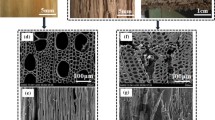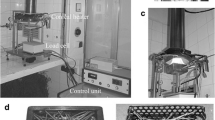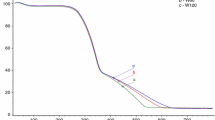Abstract
Fluffy seed hairs own very fast burning speed, which covers all corners of the city in spring and is easy to cause urban fire. In order to study the combustibility of typical seed hairs, seed hairs from poplar and plane trees were performed using thermogravimetric analysis and microscale cone calorimetry tests, which were then connected with Pearson correlation algorithm. Results were found that burning behavior of the seed hairs from poplar and plane tree is quite similar and was also akin to many other biomasses that were used as solid fuels in different parts of the world (e.g., wheat straw and rice husk). Owing to the danger of fire resulting from the dispersion of these seed hairs in mainly urban and also somewhat in wild environment, they should be collected and used as solid fuels, thus simultaneously adding value to a waste stream and making them innocuous for the environment.












Similar content being viewed by others
References
Lyon R, Walters R, Stoliarov S. Thermal analysis of flammability. J Therm Anal Calorim. 2007;89(2):441–8. https://doi.org/10.1007/s10973-006-8257-z.
Yang CQ, He Q. Textile heat release properties measured by microscale combustion calorimetry: experimental repeatability. Fire Mater. 2012;36(2):127–37. https://doi.org/10.1002/fam.1093.
Lyon RE, Safronava N, Crowley S. Thermal analysis of polymer ignition. Fire Mater. 2018;42(6):1–12. https://doi.org/10.1002/fam.2521.
Lyon RE, Walters RN, Stoliarov SI. Screening flame retardants for plastics using microscale combustion calorimetry. Polym Eng Sci. 2007;47(10):1501–10.
Lowden LA, Hull TR. Flammability behaviour of wood and a review of the methods for its reduction. Fire science reviews. 2013;2(1):1–19. https://doi.org/10.1186/2193-0414-2-4.
Ding Y, Huang B, Li K, Du W, Lu K, Zhang Y. Thermal interaction analysis of isolated hemicellulose and cellulose by kinetic parameters during biomass pyrolysis. Energy. 2020;195:117010. https://doi.org/10.1016/j.energy.2020.117010.
ASTM D7309–13, Standard Test Method for Determining Flammability Characteristics of Plastics and Other Solid Materials Using Microscale Combustion Calorimetry. 2013.
Rezvani Ghomi E, Khosravi F, Mossayebi Z, Ardahaei AS, Dehaghi FM, Khorasani M, Neisiany RE, Das O, Marani A, Mensah RA, Jiang L, Xu Q, Försth M, Berto F, Ramakrishna S. The flame retardancy of polyethylene composites: from fundamental concepts to nanocomposites. Molecules. 2020;25(21):5157. https://doi.org/10.3390/molecules25215157.
Lyon RE, Walters R. A microscale combustion calorimeter. Federal Aviation Administration Washington DC Office of Aviation Research. 2002.
Walters RN, Safronava N, Lyon RE. A microscale combustion calorimeter study of gas phase combustion of polymers. Combust Flame. 2015;162(3):855–63.
Ding Y, Huang B, Wu C, He Q, Lu K. Kinetic model and parameters study of lignocellulosic biomass oxidative pyrolysis. Energy. 2019;181:11–7. https://doi.org/10.1016/j.energy.2019.05.148.
Ding Y, Zhang J, He Q, Huang B, Mao S. The application and validity of various reaction kinetic models on woody biomass pyrolysis. Energy. 2019;179:784–91. https://doi.org/10.1016/j.energy.2019.05.021.
Wang S, Wang Q, Hu YM, Xu SN, He ZX, Ji HS. Study on the synergistic co-pyrolysis behaviors of mixed rice husk and two types of seaweed by a combined TG-FTIR technique. J Anal Appl Pyrol. 2015;114:109–18. https://doi.org/10.1016/j.jaap.2015.05.008.
Shen DK, Gu S, Bridgwater AV. The thermal performance of the polysaccharides extracted from hardwood: cellulose and hemicellulose. Carbohyd Polym. 2010;82:39–45. https://doi.org/10.1016/j.carbpol.2010.04.018.
Wang S, Liu Q, Luo Z, Wen L, Cen K. Mechanism study on cellulose pyrolysis using thermogravimetric analysis coupled with infrared spectroscopy. Front Energy Power Eng Chin. 2007;1:413–9. https://doi.org/10.1007/s11708-007-0060-8.
Baker RR, Coburn S, Liu C, Tetteh J. Pyrolysis of saccharide tobacco ingredients: a TGA-FTIR investigation. J Anal Appl Pyrol. 2005;74(1–2):171–80. https://doi.org/10.1016/j.jaap.2004.09.005.
Cao X, Zhong L, Peng X, Sun S, Li S, Liu S, Sun R. Comparative study of the pyrolysis of lignocellulose and its major components: characterization and overall distribution of their biochars and volatiles. Biores Technol. 2014;155:21–7. https://doi.org/10.1016/j.biortech.2013.12.006.
Corazzari I, Nisticò R, Turci F, Faga MG, Franzoso F, Tabasso S, Magnacca G. Advanced physico-chemical characterization of chitosan by means of TGA coupled on-line with FTIR and GCMS: thermal degradation and water adsorption capacity. Polym Degrad Stab. 2015;112:1–9. https://doi.org/10.1016/j.polymdegradstab.2014.12.006.
Author information
Authors and Affiliations
Corresponding author
Ethics declarations
Conflict of interest
The authors have no conflict of interests.
Additional information
Publisher's Note
Springer Nature remains neutral with regard to jurisdictional claims in published maps and institutional affiliations.
Rights and permissions
Springer Nature or its licensor (e.g. a society or other partner) holds exclusive rights to this article under a publishing agreement with the author(s) or other rightsholder(s); author self-archiving of the accepted manuscript version of this article is solely governed by the terms of such publishing agreement and applicable law.
About this article
Cite this article
Xu, J. Thermal analyzing flammability of fluffy seed hair of poplar and plane trees. J Therm Anal Calorim 148, 4075–4085 (2023). https://doi.org/10.1007/s10973-023-11967-y
Received:
Accepted:
Published:
Issue Date:
DOI: https://doi.org/10.1007/s10973-023-11967-y




